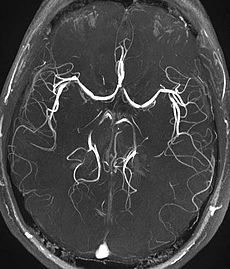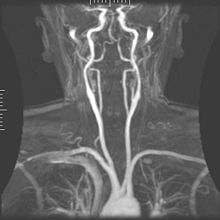- Magnetic resonance angiography
-
Magnetic resonance angiography Intervention 
Time-of-flight MRA showing the circle of Willis in the brain. Note the "venetian blinds" artifact visible as the multiple pseudo-stenosis on both the left and right middle cerebral arteryMeSH D018810 OPS-301 code: 3-808, 3-828 Magnetic resonance angiography (MRA) is a group of techniques based on Magnetic Resonance Imaging (MRI) to image blood vessels. Magnetic resonance angiography is used to generate images of the arteries in order to evaluate them for stenosis (abnormal narrowing), occlusion or aneurysms (vessel wall dilatations, at risk of rupture). MRA is often used to evaluate the arteries of the neck and brain, the thoracic and abdominal aorta, the renal arteries, and the legs (called a "run-off").
Contents
Acquisition
A variety of techniques can be used to generate the pictures, based on flow effects or on contrast (inherent or pharmacologically generated). These images, unlike conventional or CT angiography do not display the lumen of the vessel, rather the blood flowing through the vessel.
Standard
- Contrast enhanced (CE-MRA): Injection of MRI contrast agents is currently the most common method of acquiring MRA. The contrast medium is injected into a vein, and images are acquired during the first pass of the agent through the arteries. Provided that the timing is correct, this may result in images of very high quality. An alternative is to use a contrast agent that does not, as most agents, leave the vascular system within a few minutes, but remains in the circulation up to an hour (a "'blood-pool agent'"). Since longer time is available for image acquisition, higher resolution imaging is possible. A problem, however, is the fact that both arteries and veins are enhanced at the same time if higher resolution images are required.
- Time-of-flight (TOF) or Inflow angiography, uses a short echo time and flow compensation to make flowing blood much brighter than stationary tissue. As flowing blood enters the area being imaged it has seen a limited number of excitation pulses so it is not saturated, this gives it a much higher signal than the saturated stationary tissue. As this method is dependent on flowing blood, areas with slow flow (such as large aneurysms) or flow that is in plane of the image may not be well visualized. This is most commonly used in the head and neck and gives detailed high resolution images.
- Phase-contrast (PC-MRA): PC-MRA can be used to encode the velocity of moving blood in the magnetic resonance signal's phase. The most common method used to encode velocity is the application of a bipolar gradient between the excitation pulse and the readout. A bipolar gradient is formed by two symmetric lobes of equal area. By definition, the total area (0th moment) of a bipolar gradient, Gbip, is null:
- ʃ Gbip dt = 0 (1)
The bipolar gradient can be applied along any axis or combination of axes depending on the direction along which flow is to be measured (e.g. x). ΔΦ, the phase accrued during the application of the gradient, is 0 for stationary spins: their phase is unaffected by the application of the bipolar gradient. For spins moving with a constant velocity, vx, along the direction of the applied bipolar gradient:
- ΔΦ = γ vx Δm1 (2)
The accrued phase is proportional to both vx and the 1st moment of the bipolar gradient, Δm1, thus providing a means to estimate vx. γ is the Larmor frequency of the imaged spins. To measure ΔΦ,
of the MRI signal is manipulated by bipolar gradients (varying magnetic fields) that is preset to a maximum expected flow velocity. An image acquisition that is reverse of the bipolar gradient is then acquired and the difference of the two image is calculated. Static tissues such as muscle or bone will subtract out, however moving tissues such as blood will acquire a different phase since it moves constantly through the gradient, thus also giving its speed of the flow. Since phase-contrast can only acquire flow in one direction at a time, 3 separate image acquisitions in all three directions must be computed to give the complete image of flow. Despite the slowness of this method, the strength of the technique is that in addition to imaging the flowing blood, quantitative measurements of blood flow occur at the same time.Research
- Fresh blood imaging (FBI): An imaging technique using fast or super fast spin echo sequences (FSE/SFSE). Takes advantage of the longer T2 relaxation of blood compared to surrounding tissue. The images are acquired by fast spin echo sequences that can be synchronized with heart beats.
- 4D Dynamic MR Angiography (4D-MRA): The first images, before enhancement, serve as a subtraction mask to extract the vascular tree in the succeeding images. Allows to divide arterial and venous phases of a blood-groove with visualisation of its dynamics. Much less time has been spent researching this method so far in comparison with other methods of MRA.
- BOLD venography or Susceptibility weighted imaging: This method exploits the susceptibility differences between tissues and uses the phase image to detect these differences. The magnitude and phase data are combined (digitally, by an image-processing program) to produce an enhanced contrast magnitude image which is exquisitely sensitive to venous blood, hemorrhage and iron storage. The imaging of venous blood with SWI is a blood-oxygen-level dependent (BOLD) technique which is why it was (and is sometimes still) referred to as BOLD venography. Due to its sensitivity to venous blood SWI is commonly used in traumatic brain injuries (TBI) and for high resolution brain venographies.
Similar procedures to flow effect based MRA can be used to image veins. Called Magnetic resonance venography (MRV) this can be achieved by exciting a plane inferiorly while signal is gathered in the plane immediately superior to the excitation plane, and thus imaging the venous blood which has recently moved from the excited plane. Differences in tissue signals, can also be used for MRA. This method is based on the different signal properties of blood compared to other tissues in the body, independent of MR flow effects. This is most successfully done with balanced pulse sequences such as TrueFISP or bTFE. BOLD can also be used in stroke imaging in order to assess the viability of tissue survival.
Artifacts
MRA techniques in general are sensitive to turbulent flow, which causes a variety of different magnetized proton spins to mix inside a single voxel thus causing a local loss of signal (intra voxel dephasing). This can cause mis-diagnosis of stenosis. Other types of MRA related artifacts include:
- Phase-contrast:
- Phase wrapping: caused by the under estimation of maximum blood velocity in the image. The fast moving blood about maximum set velocity for phase-contrast MRA gets aliased and the signal wraps from pi to -pi instead making flow information unreliable. This can be avoided by using velocity encoding (VENC) values above the maximum measured velocity. It can also be corrected with the so called phase-unwrapping.
- Maxwell terms: caused by the switching of the gradients field in the main field B0. This cause the over magnetic field to be distort and give inaccurate phase information for the flow.
- Time-of-Flight:
- Laminar flow: In certain vessels, the blood flow is slower on the vessel walls than near the center. This causes some of the blood near the walls to become saturated further upstream in the vessel.
- Venetian blinds: Since the technique acquires images in slabs, non-uniform flip angles due to uneven distribution of the sinc pulses resulting in non-uniform signal intensity
Visualization
Occasionally, MRA directly produces (thick) slices that contain the entire vessel of interest. More commonly, however, the acquisition results in a stack of slices representing a 3D volume in the body. To display this 3D dataset on a 2D device such as a computer monitor, some rendering method has to be used. The most common method is Maximum intensity projection (MIP), where the computer simulates rays through the volume and selects the highest value for display on the screen. The resulting images resemble conventional catheter angiography images. If several such projections are combined into a cine loop or QuickTime VR object, the depth impression is improved, and the observer can get a good perception of 3D structure. An alternative to MIP is direct volume rendering where the MR signal is translated to properties like brightness, opacity and color and then used in an optical model.
Clinical use
MRA has been successful in studying many arteries in the body, including cerebral and other vessels in the head and neck, the aorta and its major branches in the thorax and abdomen, the renal arteries, and the arteries in the lower limbs. For the coronary arteries, however, MRA has been less successful than CT angiography or invasive catheter angiography. Most often, the underlying disease is atherosclerosis, but medical conditions like aneurysms or abnormal vascular anatomy can also be diagnosed.
An advantage of MRA compared to invasive catheter angiography is the non-invasive character of the examination (no catheters have to be introduced in the body). Another advantage, compared to CT angiography and catheter angiography, is that the patient is not exposed to any ionizing radiation. Also, contrast media used for MRI tend to be less toxic than those used for CT angiography and catheter angiography, with less people having any risk of allergy. Also far less is needed to be injected into the patient. The greatest drawbacks of the method are its comparatively high cost and its somewhat limited spatial resolution. The length of time the scans take can also be an issue, with CT being far quicker. It is also ruled out in patients who are unsafe for MRI (such as having a pacemaker or metal in the eyes or certain surgical clips).
MRA procedures for visualizing cranial circulation are no different to the positioning for a normal MRI brain. Immobilization within the head coil will be required. MRA is usually a part of the total MRI brain examination and adds approximately 10 minutes to the normal MRI protocol.
See also
External links
Health science – Medicine · Surgery · Vascular surgery and other vascular procedures (ICD-9-CM V3 38-39, ICD-10-PCS 03-6) Incision, excision,
and occlusion
of vesselsPeripheral arterial occlusive disease: Balloon embolectomy · Thrombectomy
Carotid stenosis: Endarterectomy (Carotid endarterectomy)
Varicose veins: Ambulatory phlebectomy · Laser ablation · Sclerotherapy · Vein stripping
Temporal artery biopsy
Arteriotomy · PhlebotomyOther operations
on vesselsPeripheral arterial occlusive disease: Peripheral arterial bypass surgery
Portal hypertension: Transjugular intrahepatic portosystemic shunt (TIPS) · Distal splenorenal shunt procedure
Vascular grafting (Human umbilical vein graft)
Blalock–Taussig shuntRepairAortic aneurysm / dissection: Open AAA repair · Endoluminal AAA repair (EVAR)
Peripheral arterial occlusive disease: Angioplasty with/out Stenting
AtherectomyAuxiliary to
heart surgeryOtherMedical imaging Angiography (Digital subtraction angiography, Cerebral angiography, Aortography, Fluorescein angiography, Radionuclide angiography, Magnetic resonance angiography)
Venography (Portography) · Impedance phlebography
Intravascular ultrasound · Carotid ultrasonographyOther diagnostic Categories:
Wikimedia Foundation. 2010.

